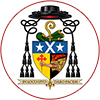The choir of Pluscarden Abbey
An appeal was launched in 1980 to re-roof and restore the Choir to mark the 750th anniversary of the founding of the Abbey in 1230 and 1,500 years from the birth of St. Benedict.
The choir of the Abbey Church opens to the east of the Transept Chapels. The visitor looks from the entrance towards the original site of the High Altar. In the wall to the north of this there is a finely-carved Sacrament House showing the figures of two kneeling angels, and also in the choir are three comparatively well-preserved sedilia. Below the windows are more consecration crosses, Architecturally this part of the Abbey presents several teasing problems, not least interesting of which is the correspondence between the mason's marks found on the stones here and those at Hexham Abbey in Northumberland.
Again, there is a puzzling appearance of Romanesque detail which seems to represent a very late survival of an earlier architectural mode; and all about the walls there are signs of altered planning, constructional second-thoughts that have produced unexpected contradictions in the symmetry of mouldings and window-openings. Some of these alterations probably followed the great fire but others were obviously necessitated by an over-ambitious allowance of window-space in the north and south walls. In its original conception, in fact, the windows of Pluscarden Choir must have made it a medieval wonder, and even today the east gable wall, with its four lancets, triplelight, aureole and trefoil openings topping each other, windows had to be replaced by solid masonry, probably as much for reasons of climate as to help to bear the weight of the roof.
The choir of Pluscarden Abbey can fairly claim to have had the first glass on this scale anywhere in Scotland. It may also be of interest to mention before quitting the choir that in the 17th century it was termed the Ogilvie Aisle and served then as a burying place for the Ogilvie family who lived nearby, some of whose tombstones can still be seen.
The altar and organ
Against the south wall of the sanctuary is the organ which is used to accompany Lauds, Vespers and Compline. On Sundays and Feast days, Mass and Benediction are also accompanied, and we usually have a small congregation who join in singing the chant ordinaries. The pipe organ is found to be very helpful in maintaining pitch and for giving a rhythmic lead when the whole community sings. Apart from this strictly functional role, the organ is also used for solo voluntaries, especially on more festive occasions.
In the 1990s the community was dissatisfied with the current organ, built in the 1890's and the only known work of an amateur builder called James Graham from Carnoustie. Dr John Rowntree produced a specification for a new instrument which would cover the needs of the chant and also cater for a considerable repertoire of solo organ music. Kenneth Tickell was then awarded the contract to build an instrument according to this specification which would blend with its surroundings and be a noble addition to the sanctuary. The casework is of light oak. The organ is slim, only 1 metre deep, with panelling similar to that of the choirstalls. The pipe screen, designed by a member of the community, has a hexagonal design recalling the wild honey eaten by John the Baptist (Matthew 3:4) and fleurs-de-lys as a symbol of Our Lady. All the pipes are enclosed inside the swell-box, except for the Open Diapason (which forms the prospect) and the Subbass. For the sake of compactness, all of the enclosed 8' stops share the lowest octave, which belongs to the Stopped Diapason; and the two manuals share the same soundboard. The swell shutters are immediately behind the Open Diapason. The specification is as follows:
Manual 1
Open Diapason 8' Stopped Diapason 8' Principal 4' Fifteenth 2' Sesquialtera II
Manual 2
Salicional 8' Clarabella 8' Voix Céleste 8' Flute 4'
Pedal
Manual 1 to Pedal, Manual 2 to Pedal
An inter-manual coupler was deemed unnecessary.
As congregational hymns are hardly ever sung at Pluscarden, the Diapason chorus was not the prerequisite which it is on almost every church organ. The Open is a suitable accompaniment for congregation singing on Sundays, for example the Credo. Furthermore, since the Principal and the Fifteenth are enclosed, they too are easily used, sometimes an octave down. The Céleste might cause some controversy in an organ this size, but it has been found a very agreeable tone for occasional accompaniment. The Clarabella was Kenneth Tickell's own idea and it is a great success. Initially we had thought that a Chimney Flute would provide a suitable variant to the Stopped Diapason for flute accompaniment, but Kenneth Tickell felt that an open flute would do the job better, having more even harmonics than a stopped flute and thus more useful for accompaniment of voices. It is a beautiful stop on its own and also blends perfectly with the Salicional to produce a small diapason.
The organ was blessed for liturgical use in July 1998, and since then it has been a continuous source of delight. In September 1998 we had a public recital by Joseph Cullen as part of our Golden Jubilee celebrations. The Scottish composer James MacMillan composed an organ piece specially for the recital: "Gaudeamus in Loci Pace".
